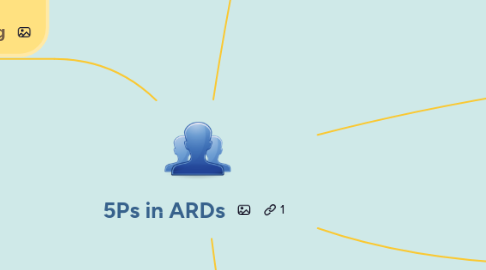
1. Protocol weaning
1.1. 1.ระยะก่อนเริ่มหย่าเครื่องช่วยหายใจ
1.1.1. Crinical stable
1.1.2. Adequate mental
1.1.3. Adequate oxygen
1.1.3.1. PaO2/FiO2ratio >150
1.1.3.2. O2sat > 92%
1.1.3.3. PEEP < 5 cmH2O
1.1.4. Hemodynamic stable
1.1.4.1. ไม่มีภาวะ MI
1.1.4.2. BP>90/60 mmHg
1.1.4.3. ไม่ใช้ยา Vasodepressor drug
1.1.4.4. หรือใช้ยา Dopamine< 5 cmg/kg/min
1.1.5. สามารถหายใจได้เอง
1.1.6. Electrolyte balance
1.1.7. T ≤ 40°C
1.1.8. P Peak < 20 cmH2O
1.1.9. Hb > 7 mg%
1.2. 2.Short Peroid Spontaneous Breathing Trail ( Short Peroid SBT)
1.2.1. ใช้เวลา 5 นาที
1.2.2. กรณีใช้ Bird’s ventilator
1.2.2.1. On Oxygen T-piece 8L/min,Fio2 0.4
1.2.3. Empowerment
1.2.3.1. ให้กำลังใจ
1.2.3.2. ให้ความมั่นใจ
1.2.3.3. คอยดูแลอย่างใกล้ชิด
1.2.4. จัดท่านั่งศีรษะสูง 70°-90°
1.2.5. บันทึกสัญญาณชีพ
1.2.5.1. BP,HR,RR,O2sat
1.2.5.2. เฝ้าประเมินใกล้ชิดใช่วง 5 นาที
1.2.6. ข้อบ่งชี้ในการหยุดทำ Short Peroid SBT แล้วให้ Back up กลับไป mode setting เดิม
1.2.6.1. RR<10,>35/min
1.2.6.2. HR<50,>140/min
1.2.6.3. BP<90/60,>180/90 mmHg
1.2.6.4. O2Sat <90%
1.2.6.5. ผู้ป่วยมีอาการกระสับกระส่ายหรือแจ้งว่าทนไม่ไหว
1.3. 3.Long Peroid Spontaneous Breathing Trail(120 min-BTS)
1.3.1. ใช้เวลา 120 นาที
1.3.2. กรณีใช้ Bird’s ventilator
1.3.2.1. On Oxygen T-piece 8L/min,Fio2 0.4
1.3.3. ทำต่อจาก Short Peroid SBT
1.3.4. ติดตามอาการทุก 15-30 นาที
1.3.5. ถ้ามีข้อบ่งชี้ในการหยุดทำเหมือน Short Peroid SBT
1.3.5.1. Back up กลับไป mode setting เดิม
1.3.6. ครบ 120 นาที
1.3.6.1. PASS
1.3.6.1.1. พิจารณาเรื่อง Extubation tube
1.4. 4.พิจารณา Exatubaton
1.4.1. หลังครบ 120 min-SBT
1.4.2. พิจารณา Extubation ในเวรเช้า
1.4.3. ผู้ป่วยที่มีลักษณะดังต่อไปนี้ข้อใดข้อหนึ่งควร Intubation ไว้ก่อน
1.4.3.1. GCS < 8,unconcious หรือซึมมาก
1.4.3.2. มีเสมหะจำนวนมากและไม่มีแรงไอขณะ suction
1.4.3.3. มีประวัติ secretion obstruction หรือ Re-incubation ภายใน 48 ชม. หลัง extubation
1.4.3.3.1. ถ้าจะ extubation ควรมีแพทย์เจ้าอยู่ด้วย
1.4.4. ถ้าไม่สามารถ Extubation ได้ใน 2 wks.
1.4.4.1. พิจารณาทำ Tracheostomy
2. Preventing complications
2.1. Pressure ulcer
2.1.1. ประเมิน Barden score
2.1.2. Skin care
2.1.3. Rotating circulation with mobilization
2.1.4. Frequent Position changes ทุก 2 ชม.
2.1.5. ดูแลผ้าปูที่นอนให้เรียบตึง
2.2. Decrease Nutrition status
2.2.1. จากผล albumin
2.2.2. แบบประเมินภาวะทุพโภชนาการ
2.2.3. Start Nutrition support (EN) in 24 hours. For Admission,if possible
2.3. Bowel ileus
2.3.1. ฟัง bowel sound
2.4. DVT.
2.4.1. ROM, Active or passive exercise
2.4.2. Applying warm,moist compression
2.4.3. Frequent Position changes ทุก 2 ชม.
2.4.4. Elevating the affected leg
2.5. VAP.
2.5.1. Head up 30°-45°
2.5.2. Mouth care for protective bacteria
2.5.2.1. The mouth
2.5.2.2. GI Tract
2.5.3. ป้องกัน Aspiration
2.5.4. Early weaning
2.5.5. Frequent Position changes ทุก 2 ชม.
3. Perfusion
3.1. Maximizing transport of oxygen between alveolar and pulmonary capillaries
3.2. IV-Fluid therapy
3.3. Meds-Inotropes,Vasopression
3.3.1. Dopamine
3.4. Remind : Volume overload
3.4.1. Neurogic
3.4.1.1. Change in LOC
3.4.1.2. Confusion
3.4.1.3. Headach
3.4.1.4. Seizure
3.4.2. Respiratory
3.4.2.1. Pulmonary Congestion
3.4.3. Cardiovascular
3.4.3.1. Bounding Pulse
3.4.3.2. ↑BP
3.4.3.3. ↑JVD
3.4.3.4. presence of S3
3.4.3.5. Tachycardia
3.4.4. Gastrointestinal
3.4.4.1. Anorexia
3.4.4.2. Nausea
3.4.5. Edema
3.4.5.1. Dependent pitting edema
3.5. การพยาบาล
3.5.1. Record V/S,N/S,I/O,monitor O2 satuation
3.5.2. ฟัง Lung sound
3.5.3. ประเมินการบวม
3.5.3.1. ชั่งน้ำหนักทุกวัน
3.5.4. Fluid restriction
4. Position
4.1. Kenetic therapy
4.2. Continuous lateral rotation therapy
4.3. Prone position
4.4. Remind
4.4.1. 40 ° or more than per side
4.4.2. Frequent Position changes ทุก 2 ชม.
4.4.3. Head up 30°-45°
5. Protective Lung Ventilator
5.1. Support organ function
5.2. Providing adequate ventilator and oxygenation
5.3. Protective ( Ventilator Induce Lung Injury:VILI)
5.3.1. Barotrauma
5.3.1.1. High pressure induced lung damage
5.3.2. Volutrauma
5.3.2.1. Over distention of alveoli
5.3.3. Atelectrauma
5.3.3.1. Repititive open and closing of alveoli and collapse
5.3.4. Biotrauma
5.3.4.1. Inflammatory cytokinase into systemic circulation →organ disfunctiono
5.4. การพยาบาล
5.4.1. Limiting Plateau Pressures <30cm 2.Maintaining PEEP 3.Reducing FiO2 50%-60% 4.Providing Low Tidal Volumes (6ml/kg of ideal body weight)

